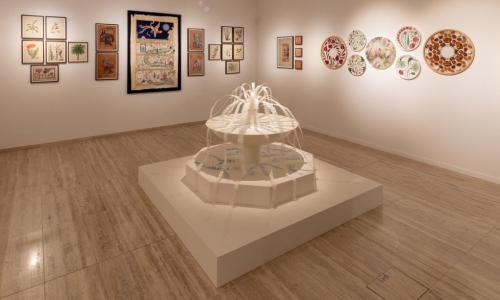Paradise found: London gallery showcases art inspired by Islamic garden design 2021-05-14
Nature-driven artist and environmentalist Clare Celeste Börsch among contributors to exhibition exploring concept of Eden
As in many paradise gardens, particularly those inspired by Islamic culture, a fountain lies at the heart of the quadrilateral garden created inside the Aga Khan Centre gallery in King’s Cross, London. This fountain doesn’t spout water, however, but beautiful, intricate strips of paper with laser-cut flowers made by Berlin-based American artist Clare Celeste Börsch.
The fountain is at the centre of Making Paradise, an exhibition exploring the concept of Eden through art and Islamic garden design. On display are numerous artworks depicting trees, flowers and fruits, including botanical illustrations from the Royal Horticultural Society’s Lindley library collection, alongside contemporary works.
Designed by Emma Clark, a designer of Islamic gardens, and featuring Börsch’s paper water spouts, the fountain sits in the middle of the gallery, surrounded by four walls mirroring the classic Persian chahar bagh (four gardens) design.
Börsch’s work is inspired by the planet’s rapidly vanishing biodiversity. An artist and environmentalist, she creates works on paper, collages and immersive installations using hand-cut images of flora and fauna, primarily taken from the Biodiversity Heritage Library. She prints the images on recycled paper, choosing illustrations from 1900 and earlier, meaning that many species featured in her artworks have either disappeared or are at risk.
“Biodiversity is my endless muse,” she says. “We’ve forgotten that we breathe air that’s the breath of trees, we forget that we’re part of a larger carbon cycle and ecosystem. And we’ve forgotten that we’re made of minerals, that we return to carbon. We’ve forgotten that our food is grown from the earth. We have this illusion of separateness that is going to, unless we heal it, literally kill us.”
The roots of Börsch’s connection to nature come from her childhood in Brazil. She says she is “very sceptical” of solutions to the planetary crisis that rely only on technology or innovation, and instead believes it is critical that we should listen to the voices of indigenous people, learning from the ways they coexist with nature. “They make up less than 5% of the world’s population but they protect 80% of the global biodiversity,” she says.
‘Biodiversity is my muse’: Börsch in front of one of her installations at her studio. Photograph: Patricia Schichl/Courtesy of the artist
Reflecting on the extent of biodiversity loss in the last 50 years, Börsch has torn down 68% – the average decline in global vertebrate species populations between 1970 and 2016 – of one of her installations currently on display in a gallery in Malmö, Sweden, and then stitched those parts back on.
“I also wanted to repair, because I think, as bad as things are right now and as much as we will lose no matter what we do now, there is still so much that we can change and save. Nature is so resilient and creative, and you can really nurture nature. You can grow a garden, green urban spaces – there is so much potential for regeneration,” she says.
Börsch believes focusing on statistics, as many environmental activists do, might scare people, but will not necessarily move them to action. Instead, she thinks art and storytelling can have more of an impact.
At her studio in Berlin, she created the Healing Garden, a multicoloured light-drenched forest, in the first months of the Covid-19 pandemic. Börsch searched local forest floors to find branches for the installation, which is decorated with translucent leaves made from homemade bioplastic of red algae, plant gelatine, water and organic food dyes. The aim is for the artwork to be accompanied by events and workshops, as a place for public interaction, although Covid constraints mean it is yet to fully come to fruition.
I think that most people are still in the first stage of grief about what’s happening to our planet, and that is denial,” Börsch says. “I don’t mean that people are denying the science, they’re denying the scale of the loss and how it’s going to personally affect them.
“We’re not separate from nature. We are nature. When we are destroying nature, we are destroying ourselves.”
Börsch’s connection with nature is echoed in Making Paradise. Curator Esen Kaya says a key message of the show is “how important the natural world is to us
The exhibition includes a bespoke perfume to evoke the scent of a garden, and a soundscape of recorded water and birdsong. The works on display show different interpretations of paradise through the mediums of Islamic geometry, hand-stitched textiles, ceramic work, embroidered panels using dried flowers and calligraphy.
“We live in a very throwaway society, a society that neglects [the] natural environment and abuses it in lots of different ways, and Covid-19 has been a wake-up call for humankind globally,” says Kaya. “If we don’t stop and think about our consumption of the natural world, we are heading into a really bad place that we won’t be able to come back from.”
- 950 reads
 Ismaili.NET - Heritage F.I.E.L.D.
Ismaili.NET - Heritage F.I.E.L.D.